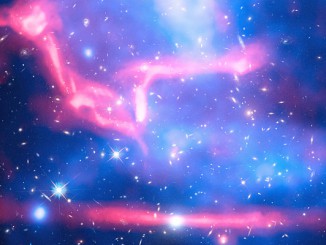
Stellar-mass black holes are thought to be five to 30 times more massive than the sun while the supermassive black holes at the centers of most galaxies can be millions to billions of times more massive. Evidence for both is widespread, but the case is less certain for intermediate-mass holes, which likely would contain thousands of solar masses.
But a team of researchers using the European Space Agency’s XMM-Newton X-ray space telescope, NASA’s Chandra X-ray Observatory and the Swift X-ray Telescope have found the best candidate yet for an elusive intermediate-mass black hole in the outskirts of a galaxy 740 million light years away.
The team, led by Dacheng Lin of the University of New Hampshire, spotted a huge flare of radiation that likely was caused by a 50,000-solar-mass black hole consuming a passing star.
“This is incredibly exciting,” Lin said in a release describing the observation. “This type of black hole hasn’t been spotted so clearly before. A few candidates have been found, but on the whole they’re extremely rare and very sought after. This is the best intermediate-mass black hole candidate observed so far.”

Intermediate-mass black holes can form in several ways but one likely scenario is the merger of massive stars in dense clusters. The problem for astronomers is that by the time such a black hole forms, there is little gas remaining in the cluster for the hole to suck in and heat up – and thus be seen – making them difficult to find.
“One of the few methods we can use to try to find an intermediate-mass black hole is to wait for a star to pass close to it and become disrupted,” Lin said. “This essentially ‘activates’ the black hole’s appetite again and prompts it to emit a flare that we can observe.
“This kind of event has only been clearly seen at the centre of a galaxy before, not at the outer edges.”
Lin and his colleagues found their candidate in images captured by XMM Newton in 2006 and 2009. Comparing that data with images collected by Chandra in 2006 and 2016 and by Swift in 2014 helped the team pin down the nature of the observation.
“We spotted the source flaring in brightness in two images from 2005, it appeared far bluer and brighter than it had just a few years previously,” Lin said. “By comparing all the data we determined that the unfortunate star was likely disrupted in October 2003 in our time, and produced a burst of energy that decayed over the following 10 years or so.”



